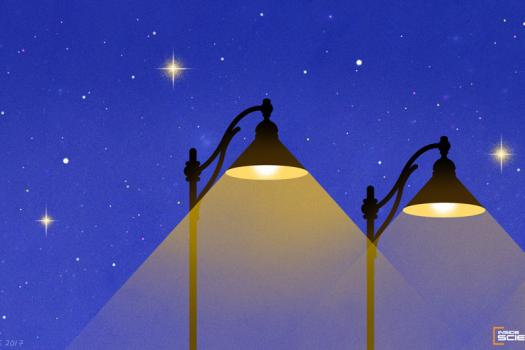What is light pollution? Mini lesson
- Lesson Plan
- Powerpoint
- Feedback Form
Light pollution can be a difficult concept to explain. In this mini lesson, students better understand the basics of light pollution through a demonstration and discussion before moving on to other hands on experiments about this subject.
Materials
• Shoe box (either one for the class, or one for each student group)
• PowerPoint presentation or constellation pictures
• Mag light or other flashlight (one per box, or take turns sharing)
• Pencils
• Pushpins
Before and After homework
The day before doing this mini lesson prepare your kids by introducing the topic of the night sky. Ask them to go outside with their parents and record what they see. Can they see the moon? Do they know any constellations? Is it easy to see the stars?
The day after the mini lesson, again ask students to go outside and record their observations. Look not only at the stars but also the surroundings around your home. Are there street lights on around your house, or lights on in the house? Try turning all the lights you can off. How does it affect how you see the stars?
Light pollution introduction demonstration activity
Explain that a constellation is a grouping of stars. Constellations are human concepts, have existed for many years, and are different in different parts of the world.
Show students sample pictures of simple constellations or the power point. Which are their favorite? Why?
Now make your own constellation! You can choose to make one as a class, or have students in groups, and make one per group. Simply choose your constellation design, draw it on your box, then poke holes in the lid of the cardboard box with a pin to form your stars.
To view your constellation, put a small flashlight inside the box (a mag light with the top off works best). Close the blinds and turn off the lights. The lights should be easily seen. Turn back on the lights with the flashlight still on and watch how easily the stars disappear.
Explain that this is how light pollution works. The stars are still there, but we cannot see them if there is too much light at night (just like we cannot see stars during the day…. but they are still there).
Light pollution is defined as “any bad effect as a result of man-made lights.” This can mean so much light that we can’t see the stars (80% of children in the U.S. cannot see the Milky Way). Or any amount of light that is affecting animals, plants and humans. Humans need darkness to help them sleep. Light pollution makes it hard for humans to get the sleep they need so they can stay healthy. Animals are affected in many different ways depending on the type of animal. Animals need 4 things to survive: Food, water, shelter and space. Light pollution can impact all of these, preventing animals from living strong, healthy lives.
Helping solve the problem of light pollution can be very simple. Some ideas include turning off outdoor lights that don’t need to be on and teaching your family and friends about the importance of darkness at night. When everyone works together to help, we can limit light pollution to save our beautiful skies and our favorite species.
Constellation pictures are in the download below.
| Attachment | Size |
|---|---|
| 336.55 KB |
On the following slides are examples of popular constellations which you could choose to put on your light pollution demonstration box.

